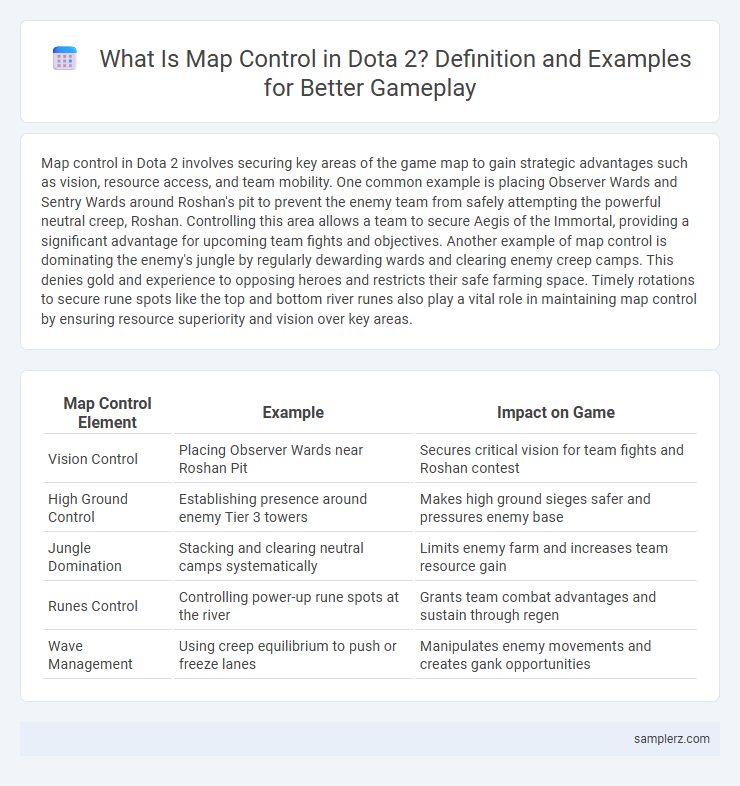Map control in Dota 2 involves securing key areas of the game map to gain strategic advantages such as vision, resource access, and team mobility. One common example is placing Observer Wards and Sentry Wards around Roshan's pit to prevent the enemy team from safely attempting the powerful neutral creep, Roshan. Controlling this area allows a team to secure Aegis of the Immortal, providing a significant advantage for upcoming team fights and objectives. Another example of map control is dominating the enemy's jungle by regularly dewarding wards and clearing enemy creep camps. This denies gold and experience to opposing heroes and restricts their safe farming space. Timely rotations to secure rune spots like the top and bottom river runes also play a vital role in maintaining map control by ensuring resource superiority and vision over key areas.
Table of Comparison
| Map Control Element | Example | Impact on Game |
|---|---|---|
| Vision Control | Placing Observer Wards near Roshan Pit | Secures critical vision for team fights and Roshan contest |
| High Ground Control | Establishing presence around enemy Tier 3 towers | Makes high ground sieges safer and pressures enemy base |
| Jungle Domination | Stacking and clearing neutral camps systematically | Limits enemy farm and increases team resource gain |
| Runes Control | Controlling power-up rune spots at the river | Grants team combat advantages and sustain through regen |
| Wave Management | Using creep equilibrium to push or freeze lanes | Manipulates enemy movements and creates gank opportunities |
Importance of Map Control in Dota 2
Map control in Dota 2 is crucial for securing vision, enabling strategic movements, and denying enemy resources. Warding key areas such as Roshan pit and jungle entrances provides team-wide information advantage, allowing for safer farming and efficient ganks. Maintaining map dominance disrupts enemy rotations and creates opportunities for objectives like towers and Barracks, directly influencing game momentum.
Warding and Vision: Securing Key Areas
Warding and vision control in Dota 2 are critical for securing key areas such as the Roshan pit, jungle entrances, and rune spots, enabling teams to anticipate enemy movements and avoid ganks. Placing Observer and Sentry Wards strategically provides map control by revealing enemy positions and dewarding opposing wards, which denies vision and limits their map presence. Maintaining vision dominance through effective warding translates into better decision-making, objective control, and overall game tempo advantage.
Controlling Rune Spawns and Power-Ups
Controlling rune spawns in Dota 2 is crucial for maintaining map control, as securing power-ups like Haste, Double Damage, or Invisibility runes provides significant tactical advantages during team fights and ganks. Effective ward placement around rune locations ensures vision and denies enemies access, enabling better resource management and pressure across the map. Teams that consistently control rune timings often dominate midlane and secure key objectives like Roshan and towers.
Dominating Neutral Objectives: Roshan and Outposts
Securing Roshan repeatedly grants significant advantages through the Aegis of the Immortal, enabling aggressive map control and team fights. Controlling Outposts provides vision, experience, and strategic positioning, allowing teams to dominate vision and initiate fights on their terms. Effective map control in Dota 2 revolves around prioritizing these neutral objectives to maintain lane pressure and dictate game tempo.
Lane Pressure and Creep Equilibrium
In Dota 2, effective map control is exemplified by maintaining lane pressure and managing creep equilibrium. Controlling the creep wave near your tower limits enemy farming potential while enabling safer hero positioning and vision dominance. Skilled players manipulate creep equilibrium to create favorable engagements and secure objectives like Roshan or tower pushes.
Smoke Ganks and Invading Enemy Jungle
Effective map control in Dota 2 is demonstrated through coordinated smoke ganks, which allow teams to move undetected and secure key kills by catching opponents off-guard. Invading the enemy jungle restricts their farm and vision, forcing them into a defensive position while increasing your team's resource dominance. This strategic pressure disrupts the enemy's economy and creates opportunities for objectives such as Roshan or tower pushes.
Denying Enemy Farming Zones
Effective map control in Dota 2 involves strategically placing wards and dewarding to limit the enemy's vision and deny access to their farming zones. By controlling key jungle entrances and stacking or clearing neutral camps, teams can restrict the opposing carry's farm potential and reduce their overall gold and experience gain. Securing runes and maintaining dominance in high-impact areas like the river further disrupts enemy movements and consolidates control over critical resources.
Strategic Tower Sieging and Defense
Strategic tower sieging in Dota 2 involves coordinated team efforts to secure Vision Control using Observer and Sentry Wards around key objectives, enabling safe initiation and minimizing enemy counterattacks. Effective tower defense leverages heroes with strong wave clear abilities and disables to stall enemy advances while maintaining map presence through counter-warding and timely rotations. Controlling high ground and Roshan pit vision further amplifies map control, dictating team fights and enabling successful sieging or defense of critical structures.
Vision Deprivation: Sentries and Dust Usage
In Dota 2, effective map control hinges on vision deprivation tools like Sentries and Dust to counter enemy invisibility and strategic positioning. Sentry Wards grant true sight, revealing invisible units and wards, while Dust of Appearance temporarily unveils hidden heroes during team fights or crucial ganks. Mastering these vision control items disrupts enemy movements, secures key objectives, and shifts the momentum in competitive gameplay.
Using Mobility Spells for Territorial Advantage
Using mobility spells like Blink Dagger or Shadow Dance allows Dota 2 players to rapidly reposition, securing key areas such as Roshan pit or high ground vantage points. Effective use of these abilities disrupts enemy pathing and vision, granting teammates safer access to objectives. Tactical mobility ensures dominance over crucial zones, enabling strategic ward placements and ambush setups.

example of map control in Dota 2 Infographic
 samplerz.com
samplerz.com